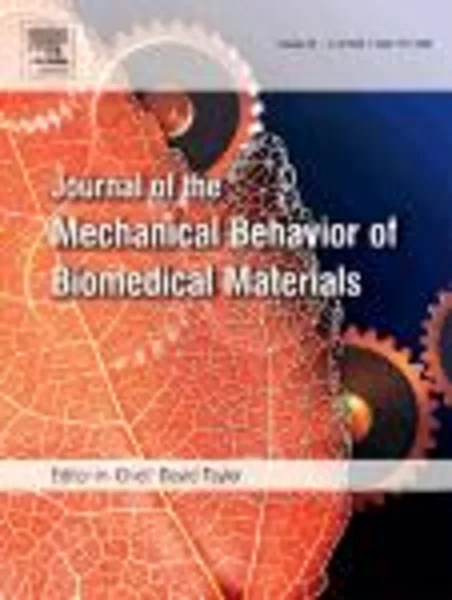-
influence of the sliding velocity and the applied potential on the corrosion and wear behavior of hc cocrmo biomedical alloy in simulated body fluids
جزئیات بیشتر مقاله- تاریخ ارائه: 1394/01/01
- تاریخ انتشار در تی پی بین: 1394/01/01
- تعداد بازدید: 684
- تعداد پرسش و پاسخ ها: 0
- شماره تماس دبیرخانه رویداد: -
the corrosion and tribocorrosion behavior of an as-cast high carbon cocrmo alloy immersed in phosphate buffered solution (pbs) and phosphate buffered solution with bovine serum albumin (pbs+bsa) have been analyzed by electrochemical techniques and surface microscopy. after the electrochemical characterization of the alloy in both solutions, the sample was studied tribo-electrochemically (by open circuit potential, ocp measurements, potentiodynamic curves and potentiostatic tests) in a ball-on-disk tribometer rotating in different sliding velocities. the influence of solution chemistry, sliding velocity and applied potential on the corrosion and tribocorrosion behavior of the cocrmo alloy has been studied. anodic current density increases with sliding velocity but wear rate does not change at an applied anodic potential; on the other hand, bsa modifies the wear debris behavior (by agglomerating the debris formed by mechanical removal of particles) thus increasing the mechanical wear volume. under cathodic conditions, cathodic current density also increases during mechanical contact while the wear rate decreases with sliding velocity and bsa lubricates the contact thus reducing the total wear volume with respect to the non-containing bsa solution. the work shows how the electrode potential critically affects the corrosion and tribocorrosion rates by increasing the wear coefficients at applied anodic potentials due to severe wear accelerated corrosion.
مقالات جدیدترین رویدادها
-
استفاده از تحلیل اهمیت-عملکرد در ارائه الگوی مدیریت خلاقیت سازمانی و ارائه راهکار جهت بهبود
-
بررسی تاثیر ارزش وجوه نقد مازاد بر ساختار سرمایه شرکت های پذیرفته شده در بورس اوراق بهادار تهران
-
بررسی تأثیر سطح افشای ریسک بر قرارداد بدهی شرکت های پذیرفته شده در بورس اوراق بهادار تهران
-
بررسی تأثیر رتبه بندی اعتباری مبتنی بر مدل امتیاز بازار نوظهور بر نقد شوندگی سهام با تأکید بر خصوصی سازی شرکت ها
-
تأثیر آمیخته بازاریابی پوشاک ایرانی بر تصویر ذهنی مشتری پوشاک ایرانی (هاکوپیان)
-
بررسی تحلیلی سیره عقلا به انضمام چگونگی کاشفیت از حکم آن و ثمرات
-
شبیه سازی معتبر رفتار قابهای عرضی در پلهای فولادی خمیده
-
ارزیابی عملکرد لرزه ای میراگرهای تسلیمی t-adas در قاب های فولادی بلند مرتبه تحت تحریکات حوزه نزدیک گسل
-
بهینه یابی سازه های قاب خمشی فولادی با استفاده از الگوریتم ژنتیک تعمیم یافته تحت قیود قابلیت اعتماد
-
تاثیرات سیستم اتوماسیون اداری و بایگانی الکترونیک بر عملکرد سازمان
مقالات جدیدترین ژورنال ها
-
مدیریت و بررسی افسردگی دانش آموزان دختر مقطع متوسطه دوم در دروان کرونا در شهرستان دزفول
-
مدیریت و بررسی خرد سیاسی در اندیشه ی فردوسی در ادب ایران
-
واکاوی و مدیریت توصیفی قلمدان(جاکلیدی)ضریح در موزه آستان قدس رضوی
-
بررسی تاثیر خلاقیت، دانش و انگیزه کارکنان بر پیشنهادات نوآورانه کارکنان ( مورد مطالعه: هتل های 3 و 4 ستاره استان کرمان)
-
بررسی تاثیر کیفیت سیستم های اطلاعاتی بر تصمیم گیری موفق در شرکتهای تولیدی استان اصفهان (مورد مطالعه: مدیران شرکتهای تولیدی استان اصفهان)
-
تاثیر اندوه مقایسه بر سایش اجتماعی با میانجی گری حسادت خاموش
-
بررسی نقش های بیولوژیک و اجتماعی - اقتصادی خرس قهوه ای (ursus arctos syriacus) در توده های جنگلی شمال ایران
-
بررسی ابعاد موفقیت پیاده سازی سیستم های هوش تجاری در شرکت های تولیدی ( مطالعه موردی: شرکت تولیدی سیمان )
-
بررسی و شناخت ماهیت مالیات و اقسام آن
-
the role of environmental graphic in the identification of urban public spaces




سوال خود را در مورد این مقاله مطرح نمایید :